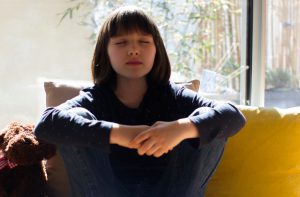Many new parents worry about raising their children. Will they be kind? Creative? Smart?
As parents, we only want to do the best for our children, but there’s no guidebook for nurturing their best qualities. Psychologists, spiritual leaders, and early childhood educators agree that mindfulness is one way to support the positive development of growing minds. Mindfulness is a way to unwind and find peace, while still honoring the whole spectrum of emotions that you feel. Over 35 million adults in America have a regular mindfulness practice, and it can be just as effective for children as it is for adults.
The Benefits of Mindfulness
The American Psychological Association recently published a meta-analysis combining data from over 40 studies on the effects of a mindfulness practice for adults. The research concluded that mindfulness has the following effects on participants:
- A reduction in stress levels
- Increased emotional awareness
- Decreased emotional reactivity
- Improved memory function
- Increased focus
- A greater sense of satisfaction with relationships
- A more positive sense of self
Research also points to the numerous health benefits of mindfulness. People who have a mindfulness practice experience a reduction in high-risk behaviors like smoking and excessive drinking, and an increase in positive health behaviors like getting regular check-ups, using seat belts, and being physically active. There are also physical effects, like a stronger immune system, decreased blood pressure, reduction of chronic pain, and lessening of gastrointestinal distress symptoms.
All of these benefits are important for children, as well, since the habits and skills they build now will last throughout their lifetimes. There are also additional benefits associated with mindfulness for children, as reported in many studies from the American Academy of Child and Adolescent Psychology.
- Cognitive flexibility, which allows children to disengage from conflict and calm down more quickly after being provoked or upset.
- Prosocial behaviors in the classroom, like sharing, patience, and decreased reactivity to conflict.
- Improved executive function, which controls things like focus, memory, and organization.
How To Support Mindfulness in Children
Many adults picture mindfulness as a form of meditation: sitting cross-legged with their eyes closed, taking deep breaths, and emptying their mind. Mindfulness is less about sitting in the perfect posture and clearing the mind, and more about staying in the present moment, and paying attention to what you’re thinking, feeling, and experiencing, without judgement.
There are many ways to practice mindfulness with children in your daily life. You can be mindful while eating, drawing, or playing in the sand. An easy way to start is by drawing attention to you and your child’s actions. You can say things like, “I am noticing how crunchy and cold this carrot is” or, “I love the way this marker feels in my hand”. You can also name emotions as they come up for you and your child: “I feel so happy to be spending time with you”, or “You seem frustrated”. By naming emotions in a calm and even tone you are allowing your child to do the same. Acknowledge big feelings, then let them go without judgement.

There are also many ways to practice mindfulness more intentionally. As a preschool teacher, I would often have my three and four year old students participate in a guided meditation before naptime. Sometimes we would listen to a recording (there are many great mindfulness for children channels on YouTube!), other times I would ad-lib. They are young, so it doesn’t have to be perfect!
Starting with the kids laying down in a comfortable position, ask them to close their eyes and listen to your words. You can describe in detail your favorite place: the sounds, smells, and colors. The more detail, the better! This practice encourages children to focus on the full-body details of a moment – the way the sun feels on their skin, the sound of wind in trees, the smell of grass – and supports an attentive, but calm, state of mind.
Loving Kindness Meditation
Another form of mindfulness that works beautifully for children is the “Loving Kindness” modality. Metta Bhavana, which translates from the Pali language to “cultivation of loving-kindness”, is a Buddhist tradition, and is adaptable for all ages and abilities. This practice focuses on unconditional caring for ourselves, our friends, our enemies, and everyone, and serves as a reminder for children to approach everyone with kindness and compassion. When guiding kids through this three-part meditation, you can give them the option of repeating the mantra out loud with you or picturing an image, such as shining a light from their heart to the other person’s, or handing them a flower – anything that conveys love and care. You can do this any time, anywhere.
- First, encourage your kiddo to feel “metta” or loving, caring, compassion for themselves. Help them think of all of the things they
 love about being them – they’re a great friend, a helpful son or daughter, an amazing artist. They can picture themselves being flooded with warmth and light, or say “may I be well and happy” or “may I be filled with joy”. You can customize the mantra to fit whatever goals you have for your child.
love about being them – they’re a great friend, a helpful son or daughter, an amazing artist. They can picture themselves being flooded with warmth and light, or say “may I be well and happy” or “may I be filled with joy”. You can customize the mantra to fit whatever goals you have for your child. - Second, focus on a friend or family member. Encourage your child to picture their friend in their mind and think of all of the things they love about them. Then, repeat the mantra: “may they be well and happy” or whatever you have decided to use.
- Next, ask your child to picture someone they don’t particularly like. It can be someone they feel neutrally about, or someone they dislike – traditionally it’s an “enemy” that is pictured. As they picture this person, have them use the mantra again – “may they be well and happy”.
- Finally, have your child picture all of those people together: your child, their friend or family member, and their enemy or neutral person. Picture them all smiling, enjoying one another’s company. Then add more people to the image – your neighbors, your town, and the whole world. End with the mantra “may all people be well and happy”.
Mindfulness doesn’t have to be an intense, silent meditation. It’s about cultivating a sense of peace and presence even when things get crazy – which is a valuable skill for kiddos and adults. There are so many benefits for both the body and the mind when practicing mindfulness, so see if you can work it into your daily life. You might find that it helps your whole family navigate stressful days with resilience and compassion.
